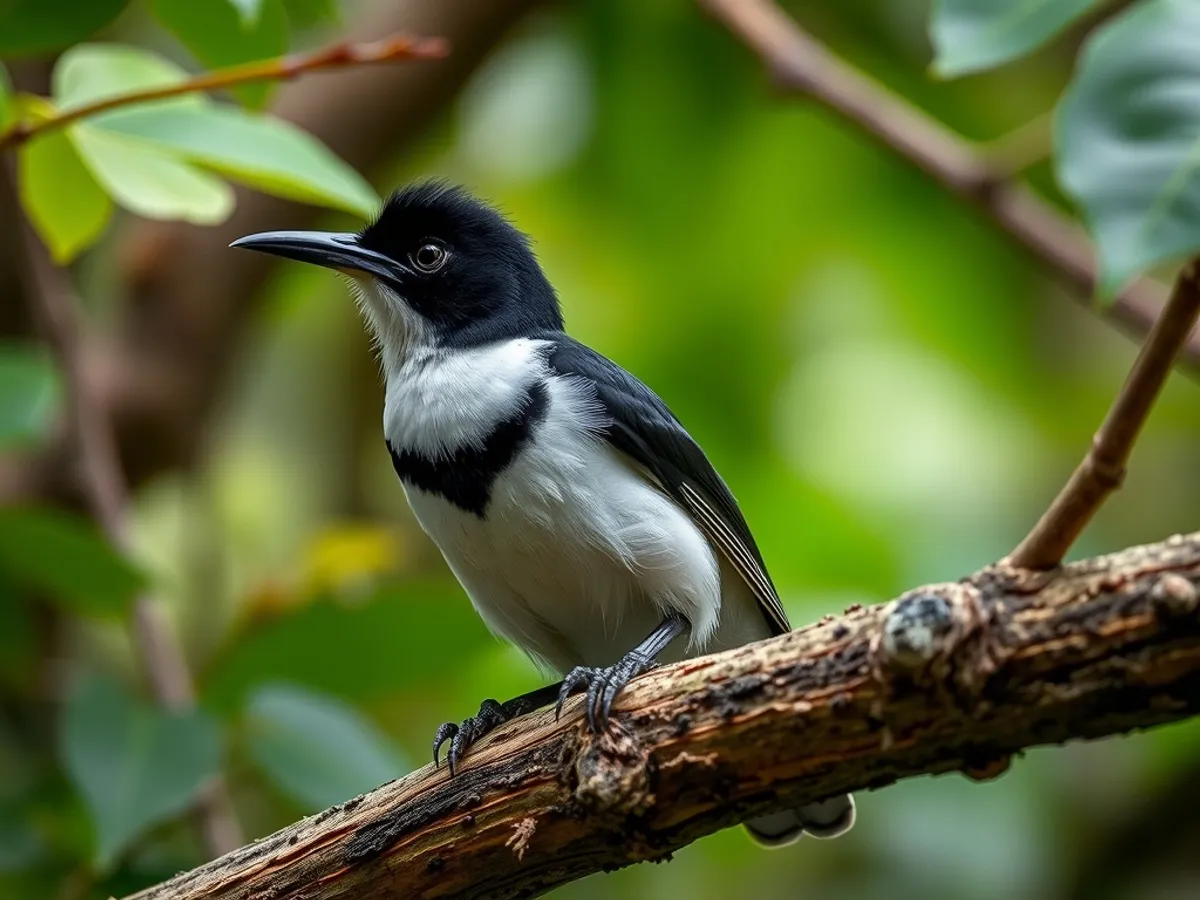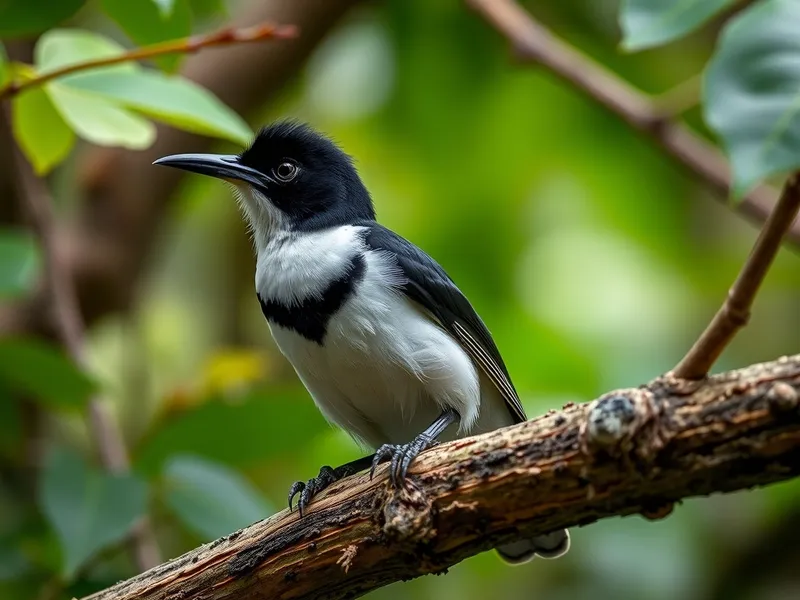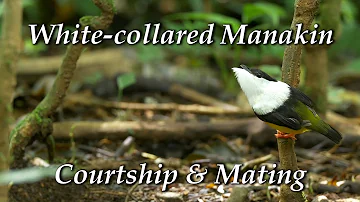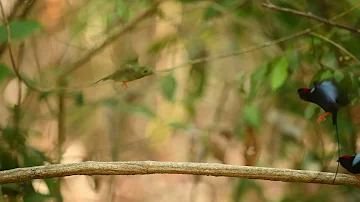
White-collared Manakin
Manacus candei

Meet the White-collared Manakin
The White-collared Manakin is a small, vibrantly colored bird native to the lowland forests of Central America. Males are notable for their striking plumage, featuring a bright white collar and black crown, contrasting with olive-green upperparts and yellow underparts, while females are generally olive-green throughout. These birds are famous for their elaborate courtship displays, where males produce snapping and buzzing sounds with their wings and perform acrobatic dances to attract females. White-collared Manakins are typically found in the dense understory of humid forests, especially near forest edges and clearings. Their presence is often detected by the distinctive mechanical sounds of their displays rather than their calls.
Classification
Bird
Habitat
Tropical and subtropical lowland forests
Diet
Frugivore
Lifespan
4-8 years
Conservation
Least Concern
Weight
14-19 grams
📖Fascinating Facts
Dazzling Dancers
White-collared Manakin males gather in leks where they perform intricate dances, including hopping between perches and making mechanical snapping sounds to impress females.
Fruit Lovers
Their primary diet consists of small fruits and berries, making them important seed dispersers within their ecosystem.
Forest Understory Resident
They prefer the dense understory of humid forests, rarely venturing into the open canopy or outside the forest’s edge.
📋Detailed Description
The White-collared Manakin (Manacus candei) is a compact passerine bird measuring approximately 10.5–11.5 cm in length and weighing 15–19 grams. Males are instantly recognizable by their crisp white 'collar'—a broad band of white feathers encircling the throat and upper breast—contrasting with a jet-black crown, nape, wings, and tail, an olive-green rump, and a vivid yellow belly. Females and juveniles are more cryptically colored, exhibiting olive-green upperparts and yellowish underparts, which provides camouflage in dense understory vegetation. The species has a short, broad bill adapted for fruit consumption, and strong legs for perching and leaping during courtship displays. White-collared Manakins are highly sexually dimorphic, with males exhibiting specialized plumage and behavior for lekking. Their wings are structurally modified to produce loud mechanical snaps and buzzes, integral to their elaborate mating displays. These birds are primarily frugivorous, feeding on a variety of small fruits and berries, but also consume insects and spiders, especially during the breeding season. They are typically found in the lower and mid-levels of humid lowland forests, forest edges, tall secondary growth, and shaded plantations, often near water sources. Socially, they are solitary or loosely associated outside the breeding season, but males congregate at traditional display sites (leks) during courtship. Their secretive habits and preference for dense cover make them more often heard than seen, with their presence betrayed by distinctive wing snaps and buzzing display sounds.
💡 Did you know?
The snapping sound made by male White-collared Manakins is created by rapidly clapping their wings together above their backs, a behavior unique among birds.
🔬Research & Sources
Wikipedia Summary
The white-collared manakin is a passerine bird in the manakin family. It is a resident breeder in the tropical New World from southeastern Mexico to Costa Rica and the extreme west of Panama. It typically inhabits thickets at the edges of moist forest, tall secondary growth and old cacao plantations. It is a small, plump bird about 11 centimetres (4.3 in) long. Males have a black crown, mid-back band, wings and tail, an olive-green rump and yellow belly. Females and juveniles are olive-green with yellow bellies and resemble female orange-collared manakins. At breeding time, males are involved in lekking behaviour on the forest floor during which they puff out their neck feathers. This is a fairly common species with a wide range, and the International Union for Conservation of Nature has rated its conservation status as being of "least concern".
Last Modified: 3/14/2025
🎭Behavior & Social Structure
White-collared Manakins are best known for their intricate lekking behavior, where males gather in small groups (leks) on the forest floor to perform competitive displays for visiting females. Each male clears a small display court, meticulously removing leaf litter to create a bare patch, and uses low perches for acrobatic jumps, rapid flights, and wing-snapping maneuvers. The wing snaps are produced by modified secondary feathers and are audible from considerable distances. Males are highly territorial within the lek, defending their courts from rivals. Outside of the breeding season, the species is generally solitary and secretive. Foraging occurs primarily in the understory, where individuals pluck small fruits, especially from Melastomataceae, Rubiaceae, and Lauraceae, often hovering briefly to snatch food. Insects and spiders are taken opportunistically, especially during periods of high protein demand such as chick-rearing. Daily activity peaks at dawn and late afternoon, with midday spent resting in dense cover. Vocalizations are relatively simple, consisting of short, sharp 'tic' or 'pip' notes, but mechanical wing sounds are the primary acoustic signals.
👶Reproduction & Life Cycle
Breeding in White-collared Manakins is highly seasonal, typically coinciding with the onset of the rainy season (March to July in Costa Rica). Males perform at leks to attract females, with the most dominant and skilled performers securing the majority of matings. After mating, females are solely responsible for nest construction, incubation, and chick rearing. The nest is a small, shallow cup woven from plant fibers, placed 1–3 meters above ground in dense vegetation. Clutch size is usually two eggs, which are pale with brownish markings. Incubation lasts about 17–20 days, and the altricial chicks fledge approximately 13–15 days after hatching. Females feed the chicks primarily with soft fruits and supplement with insects for protein. There is no male parental involvement after copulation.
🛡️Adaptations & Survival
The species exhibits several remarkable adaptations for its lekking lifestyle. Males have evolved specialized secondary wing feathers that are thickened and stiffened, enabling the production of loud mechanical snaps and buzzes during display. Their strong legs and feet facilitate rapid, agile movements and repeated leaping between perches. The cryptic coloration of females and juveniles provides effective camouflage against predators in the dense understory. Their diet is adapted to exploit a wide variety of small, soft fruits, and their digestive system efficiently processes fruit pulp while excreting seeds, aiding in forest regeneration. The ability to clear and maintain display courts is a behavioral adaptation linked to sexual selection.
📚Research Sources
🎨Cultural Significance
While the White-collared Manakin does not have a prominent role in indigenous folklore or local mythology, its striking appearance and unique courtship displays have made it a subject of interest for birdwatchers and ecotourism in Central America. The species is sometimes featured in educational materials and field guides as an example of lekking behavior and sexual selection. Its presence is considered an indicator of healthy understory habitats.
🔬Recent Research & Discoveries
Recent research on Manacus candei has focused on the biomechanics of wing-sound production, sexual selection, and the genetic basis of plumage and display traits. Studies using high-speed videography and acoustic analysis have elucidated how specialized wing feathers generate mechanical sounds. Genetic analyses have explored hybridization zones between White-collared and Golden-collared Manakins (Manacus vitellinus) in Panama, revealing insights into reproductive isolation and speciation. Long-term monitoring of lek dynamics has provided data on male site fidelity, display success, and the influence of habitat quality on reproductive output. Ongoing studies are investigating the impact of habitat fragmentation on lek stability and gene flow.
🎥Wildlife Videos

White-collared Manakin: Courtship dance and mating
Male White-collared Manakin cleaning his dancing spot and courtship a female, who join him for fast flying-jumping between ...
Eco Planet Films

White Collared Manakin in the Rainforest
Hiking in the forest!
The Club at PPGY

White-collared Manakin
Contains part of the wing-snapping "courtship" display and vocalizations of the male White-collared Manakin. Filmed in Mayflower ...
babyleon

White-collared Manakin (Manacus candei) - Courtship dance and mating
Male White-collared Manakin cleaning his dancing spot and courtship a female, who join him for fast flying-jumping between ...
Arnon Dattner

Manakin Courtship dance
The White-collared Manakin courtship is one of the most amazing behaviours taking place in Costa Rica rainforest. At mating time ...
Jérôme Guillaumot

Mannakin Movie Costa Rica
Long Tailed Manikin lekking near Orotina, Alajuela Province, Costa Rica. Taken with a Nikon D500 and 600mm VR F4. Not sure ...
hoalawman1
🌍Habitat Information
The White-collared Manakin typically inhabits Tropical and subtropical lowland forests environments. White-collared Manakins have adapted to their environments with specialized features and behaviors.
Primary Habitat:
Tropical and subtropical lowland forests
More detailed habitat information will be available soon.
🛡️Conservation Status
The White-collared Manakin is currently classified as Least Concern. Conservation efforts are crucial for preserving this species for future generations.
Common Threats:
- 🏠Habitat loss and fragmentation
- 🌡️Climate change impacts
- 🎯Hunting and poaching
- 🏭Human-wildlife conflict
⚠️Threats & Conservation Challenges
Currently, the White-collared Manakin is classified as Least Concern by the IUCN due to its wide distribution and stable population trends. However, localized threats include habitat loss and fragmentation from agricultural expansion, logging, and conversion of forests to pasture or monoculture plantations. Despite this, the species shows some resilience by utilizing secondary growth and shaded plantations (e.g., cacao) as alternative habitats. Climate change poses a potential long-term threat through alteration of forest structure and fruiting phenology. The species is not targeted by hunting or the pet trade. Ongoing deforestation in Central America could pose future risks if not mitigated.
🔬Scientific Classification
Scientific Name
Manacus candei
Classification Hierarchy
🔍 About Taxonomic Classification
Taxonomic classification is a hierarchical system used by scientists to classify and organize living organisms based on shared characteristics and evolutionary relationships.
The system moves from broad categories (Kingdom) to increasingly specific ones, with each animal's scientific name typically consisting of its Genus and species.
📝Community Notes
Share your observations and insights about the White-collared Manakin with our community of wildlife enthusiasts.
Join Our Community
Sign in to share your observations and connect with fellow wildlife enthusiasts.
Sign In to ContributeNo community notes yet
Be the first to share your observations about the White-collared Manakin!
Explore White-collared Manakin
Select a tab above to learn more about this amazing animal.
📸Photo Gallery
No photos available for this animal yet.
🌟Discover More Wildlife
Continue your journey of discovery with more fascinating animals from our database
